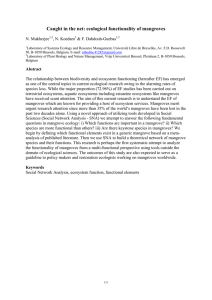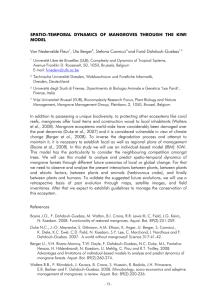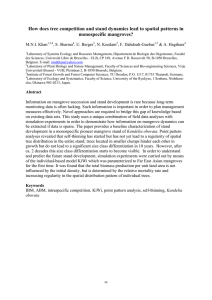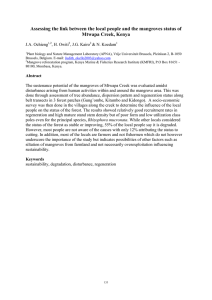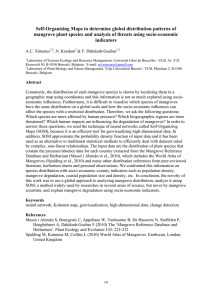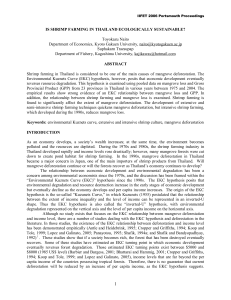CATEGORISATION OF LAND-COVER AND LAND-USE ADJACENT TO A CLASSIFICATION: STATE-OF-THE-ART
advertisement
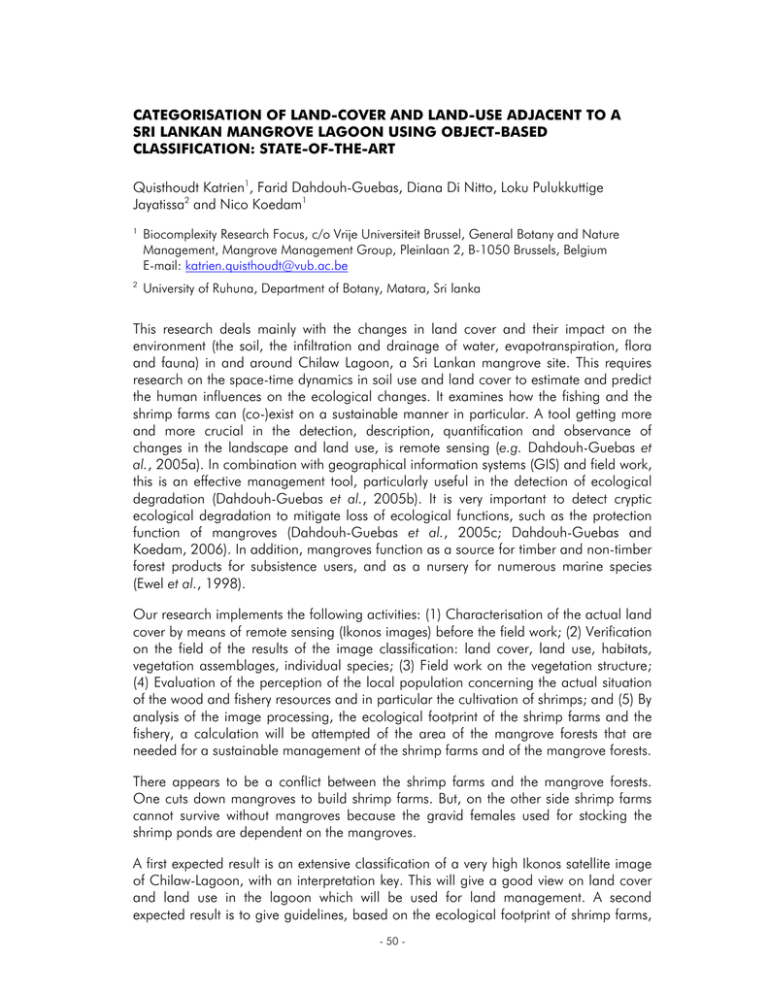
CATEGORISATION OF LAND-COVER AND LAND-USE ADJACENT TO A SRI LANKAN MANGROVE LAGOON USING OBJECT-BASED CLASSIFICATION: STATE-OF-THE-ART Quisthoudt Katrien1, Farid Dahdouh-Guebas, Diana Di Nitto, Loku Pulukkuttige Jayatissa2 and Nico Koedam1 1 Biocomplexity Research Focus, c/o Vrije Universiteit Brussel, General Botany and Nature Management, Mangrove Management Group, Pleinlaan 2, B-1050 Brussels, Belgium E-mail: katrien.quisthoudt@vub.ac.be 2 University of Ruhuna, Department of Botany, Matara, Sri lanka This research deals mainly with the changes in land cover and their impact on the environment (the soil, the infiltration and drainage of water, evapotranspiration, flora and fauna) in and around Chilaw Lagoon, a Sri Lankan mangrove site. This requires research on the space-time dynamics in soil use and land cover to estimate and predict the human influences on the ecological changes. It examines how the fishing and the shrimp farms can (co-)exist on a sustainable manner in particular. A tool getting more and more crucial in the detection, description, quantification and observance of changes in the landscape and land use, is remote sensing (e.g. Dahdouh-Guebas et al., 2005a). In combination with geographical information systems (GIS) and field work, this is an effective management tool, particularly useful in the detection of ecological degradation (Dahdouh-Guebas et al., 2005b). It is very important to detect cryptic ecological degradation to mitigate loss of ecological functions, such as the protection function of mangroves (Dahdouh-Guebas et al., 2005c; Dahdouh-Guebas and Koedam, 2006). In addition, mangroves function as a source for timber and non-timber forest products for subsistence users, and as a nursery for numerous marine species (Ewel et al., 1998). Our research implements the following activities: (1) Characterisation of the actual land cover by means of remote sensing (Ikonos images) before the field work; (2) Verification on the field of the results of the image classification: land cover, land use, habitats, vegetation assemblages, individual species; (3) Field work on the vegetation structure; (4) Evaluation of the perception of the local population concerning the actual situation of the wood and fishery resources and in particular the cultivation of shrimps; and (5) By analysis of the image processing, the ecological footprint of the shrimp farms and the fishery, a calculation will be attempted of the area of the mangrove forests that are needed for a sustainable management of the shrimp farms and of the mangrove forests. There appears to be a conflict between the shrimp farms and the mangrove forests. One cuts down mangroves to build shrimp farms. But, on the other side shrimp farms cannot survive without mangroves because the gravid females used for stocking the shrimp ponds are dependent on the mangroves. A first expected result is an extensive classification of a very high Ikonos satellite image of Chilaw-Lagoon, with an interpretation key. This will give a good view on land cover and land use in the lagoon which will be used for land management. A second expected result is to give guidelines, based on the ecological footprint of shrimp farms, - 50 - for reforestation of mangroves. And by this way to give a solution for the conflicts between adjacent land use. The research is ongoing, but this presentation discusses the state-of-the-art in the light of the above objectives and the expected results. References Dahdouh-Guebas F., E. Van Hiel, J.C.-W. Chan, L.P. Jayatissa and N. Koedam. 2005a. Qualitative distinction of congeneric and introgressive mangrove species in mixed patchy forest assemblages using high spatial resolution remotely sensed imagery (IKONOS). Systematics and Biodiversity 2(2):113-119. Dahdouh-Guebas F., S. Hettiarachchi, D. Lo Seen, O. Batelaan, S. Sooriyarachchi, L.P. Jayatissa and N. Koedam. 2005b. Transitions in ancient inland freshwater resource management in Sri Lanka affect biota and human populations in and around coastal lagoons. Current Biology 15(6):579-586. Dahdouh-Guebas F., L.P. Jayatissa, D. Di Nitto, J.O. Bosire, D. Lo Seen and N. Koedam. 2005c. How effective were mangroves as a defence against the recent tsunami? Current Biology 15(12):R443-447. Dahdouh-Guebas F. and N. Koedam. 2006. Coastal vegetation and the Asian tsunami. Science 311:37-38. Ewel K.C., R.R. Twilley and J.E. Ong. 1998. Different kinds of mangrove forests provide different goods and services. Global Ecology and Biogeography Letters 7:83-94. - 51 -
